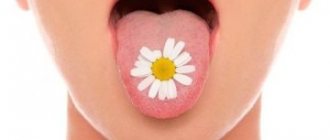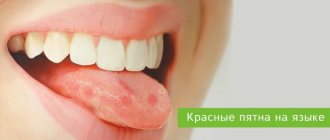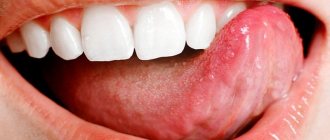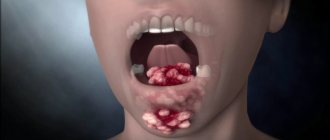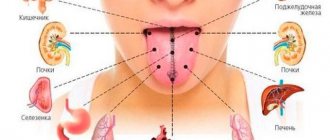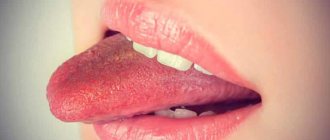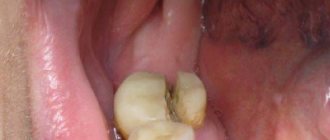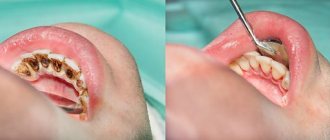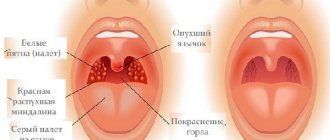Spots on the tongue are most often called geographic tongue throughout the world. This is not a diagnosis, but simply an individual feature in the structure of the language. The spots that appear on the upper part of the taste organ in the oral cavity are called papillae in medicine. Thanks to them, a person feels taste and temperature, can chew and speak.
However, spots on the tongue are different - acceptable for a healthy person and indicating illness. They are distinguished by color, size and location.
There are only four types of healthy spots:
- Mushroom spots are small spots that are located on the tip and edges of the tongue. Usually there can be from 200 to 400 and each of them contains 3-5 taste buds.
- Grooved spots are larger spots on the back of the tongue. They are arranged in a “v” pattern. A healthy person can have from 7 to 12 of them and each has thousands of taste buds.
- Leaf-shaped - papillae with hundreds of taste buds that are located along the edges and on the back of the tongue. In humans there are about 20 of them.
- Thread-like - spots without taste buds, but larger in size than others. Appears in the front and center of the tongue.
Papillae that are unusual in color, size and are accompanied by some symptoms often signal problems in the body.
Traumatic factor
Every person can experience mechanical damage to the tongue. It could be:
- biting;
- regular use of a rough toothbrush;
- damage during dental therapy;
- tissue damage from teeth, dentures, braces;
- irritation from food or medications.
Treatment of tongue sores resulting from injury occurs quickly and without complications. For the first few days, the damaged mucous membrane will react to all irritants. But the reaction will become less and less every day, and over time it will completely disappear.
Dental problems
Wondering how blisters on the tongue are related to dental pathologies? Incorrect bite, the presence of chipped and damaged teeth, poorly fitted orthopedic and orthodontic structures can lead to periodic and systematic injury to the muscular organ and its biting. In most cases, after an injury, a single blister forms on the tongue, which, depending on the depth and severity of the injury, sometimes becomes filled with blood.
In fact, dental pathologies most often lead to tongue injuries in adults, when red, bleeding wounds and blisters appear on the tissue. But in children, the appearance of rashes on a muscle organ is often caused by a restless lifestyle: while playing, children fall, hit themselves, and can bite their tongue until it bleeds.
After an injury, a blister may form on the tongue, which is sometimes filled with blood.
Sometimes it’s not a traumatic factor at all. Formations on the tongue can appear under the influence of pathogenic bacteria that live in plaque, which is abundantly deposited on the surface of the teeth and gums. This happens if a person does poor oral hygiene and only for show, does not treat in a timely manner and causes caries, pulpitis, gingivitis, and periodontitis.
“One time I began to notice that some kind of bubble with blood inside came out on my tongue. It looked like something had damaged the tissue. I went to the dentist, he said: yes, there are problems in my mouth. I corrected all the flaws and restored some of my teeth. But this infection did not go away, but seemed to begin to grow even more. Then, reluctantly, I went to a therapist, who, after an examination, urgently sent me to an oncologist. He diagnosed him with hemangioma. It’s good that this infection turned out to be benign, it was removed, and the prognosis is favorable. Doctors said it could have been caused by simply biting the tongue while the teeth were in poor condition, even before going to the dentist.”
Evi, review from woman.ru
Stomatitis
Stomatitis is a rather insidious disease. Experts distinguish several stages. Each of them has its own symptoms and characteristics.
The main stages of a sore on the tongue include:
- Aphthous stomatitis.
This problem occurs in both children and adults with weak immune systems. This stage is characterized by regular rashes in the form of bleeding ulcers and wounds.
Important! Aphthous stomatitis easily becomes chronic! The fight against this problem may not last for many years. In this case, the patient is accompanied by severe itching and discomfort. Therefore, when the first symptoms appear, you need to consult a doctor.
- Candidal stomatitis.
This sore often occurs on the tongue in children aged 0 to 6 years. Among the main symptoms are a strong white coating on the gums, cheeks and bleeding wounds. If the problem is not overcome in time, the child will not be able to eat normally, the temperature will rise and sleep will worsen.
- Herpetic stomatitis.
The name speaks for itself. This disease occurs after the herpes virus enters the body. The symptoms are exactly the same as herpes, the only difference is that watery pimples and ulcers spread along the inside of the cheeks or on the tongue.
A rash in the mouth may indicate the presence of coronavirus in a patient
Mucocutaneous lesions occur on average 12 days after the onset of other symptoms of the disease. Previously it was reported that infection with coronavirus can manifest itself in the form of a rash on the skin and even lead to the appearance of ulcers inside the mouth, the authors of this study for the first time stated that one of the symptoms of the virus may be enanthema - a rash on the mucous membrane.
Enanthema manifests itself as multiple small spots on the mucous membrane. The authors suggested that dentists can regard this sign as one of the symptoms of coronavirus and protect themselves if they inspect the mucous membranes for the presence of a rash before starting treatment.
“The presence of enanthema on the mucous membrane most likely indicates the viral nature of the rash,” says the author of the study, MD. Juan Jiménez-Coch, representing the Department of Dermatology at the Ramon y Cajal University Hospital in Madrid.
At the moment, researchers continue to work on finding drugs to fight the virus and developing a vaccine. At the same time, the list of symptoms of the disease is expanding, among which the most common are: headache, fever, sore throat. Less common symptoms include diarrhea, loss of smell and taste, vasculitis, and a rash similar to chickenpox. Enanthema will probably soon be added to this list.
At the university hospital, among patients with confirmed coronavirus, 21 patients were identified who also had manifestations of a rash. Among this group, enanthema variants were found in 6 patients. The age of patients from the study group was from 40 to 69 years, among them there were 4 women and 2 men.
Different types of enanthems
One patient had a macular type of enanthema, two had a petechial type, and three had both types of enanthema. The rash was localized to the palate.
In patients with petechial enanthema, the rash appeared faster than in patients with the macular type of rash. Laboratory tests of the patients did not reveal any abnormalities that could explain the appearance of the rash by another cause. The use of medications by patients also could not be associated with the appearance of enanthema. It is known that such rashes often occur under the influence of a viral load, although sometimes they can act as an adverse reaction to taking medications.
A reliable characteristic of the viral origin of the rash is its localization in the oral cavity. Vesicular and petechial types of rash are associated with the entry of the virus into the body, and the petechial type of enanthema is more common in adult patients.
In this study, 83% of patients had a petechial type of enanthema, or a predominantly petechial type. It is noteworthy that in two patients the rash appeared either 2 days before the onset of the main symptoms of coronavirus, or 2 days after the onset of these symptoms. In this regard, the authors made a convincing assumption that the rash in these patients could not appear as a reaction to taking medications.
The study authors report that the validity of the results may have been affected by the small number of participants and the lack of a control group of patients. “Although doctors are increasingly reporting cases of rashes in patients with confirmed coronavirus, it remains difficult to determine what the true causes of skin rashes are,” the authors say.
Papillomas
A complication of the papilloma virus can cause a sore on the tongue. The warts themselves are not dangerous, but you need to avoid damaging them. This threatens the appearance of a malignant neoplasm.
Do not confuse papillomas with genital warts. The latter are much more dangerous. They are often injured, thereby infecting other adjacent areas of the skin. The regular appearance of condylomas indicates a person’s predisposition to cancer.
Signs of normality and pathology
The tongue is a muscular organ that is responsible not only for our speech and perception of the taste of food, but also often signals problems occurring in the body. In its normal state it is pinkish, the tissue structure is homogeneous. The organ can be covered with a whitish coating (most often in the morning), or colored deposits from food: both types are easily removed with a brush or scraper.
In normal condition, the tongue is pinkish
If spots and blisters of different colors and in different quantities appear on the tongue, this indicates a negative impact on the tissue of external factors, or the occurrence of pathological processes and various diseases in the body1. In this case, the neoplasms can itch, burn, hurt, itch, burst, become covered with a crust and a foul-smelling coating.
We will analyze all the main reasons further.
Features of treatment of stomatitis
The therapeutic regimen is selected taking into account the cause of the disease. The approach must be comprehensive. To relieve pain symptoms, you need to use medications containing lidocaine. These can be gels, tablets, rinsing solutions.
If it turns out that the pathology is caused by herpes, you need to use antiviral drugs, including oxolin and acyclovir. In case of severe inflammation, medications with the addition of solcoseryl, vitamins, and oils help. If the culprit of the pathology is bacteria, the use of dental ointments based on chlorhexidine, miramistin, furatsilin, metronidazole, chlorophyllipt is indicated.
When a disease is of a fungal nature, antifungal compounds come to the rescue. Their active substances are nystatin, clotrimazole, miconazole. Rinsing your mouth with a weak soda solution helps with fungus.
If during the examination it is determined that the tongue is damaged as a result of the progression of an allergic reaction, general-spectrum antihistamines are prescribed. In the presence of diseases of the gastrointestinal tract, the activity of the stomach and intestines is first of all normalized. Usually, after eliminating the underlying disease, cases of stomatitis also disappear.
In order for positive dynamics to emerge as quickly as possible, the patient must follow all medical prescriptions and not stop treatment ahead of time. Then the ulcers will heal within three to seven days, the pain will be a thing of the past.
Prevention
To avoid the appearance of a rash on the tongue in the form of warts, pimples, ulcers or blisters, you must adhere to the following preventive rules:
- completely give up addictions;
- do not eat excessively hot and spicy foods;
- use only high-quality oral care products;
- promptly treat those diseases that can lead to the appearance of a red or white rash;
- undergo a complete medical examination several times a year.
The prognosis of rashes on the tongue is dictated by the etiological factor, but since such a specific symptom forces people to seek qualified help, the prognosis is often favorable.
Causes
The most common reasons :
- Food is too spicy or hot . Because of this, the mucous membrane and taste buds are irritated. They begin to itch, inflammation develops, and pain appears. If you often notice such inflammation, it is possible that it is time to give up spicy and too hot foods, seasonings and spices. If these symptoms are ignored, glossitis may develop.
- Internal inflammation . Diseases of the internal organs often cause a similar symptom. If acne does not go away and bothers you for a long time, you need to share the problem with a doctor and get examined. They can be provoked by a very serious illness. Treatment of the underlying pathology may be required here.
- Herpes. It affects not only the lips, but also the entire oral mucosa and tongue. In this case, the pimples will be watery and painful. The danger of herpes should not be underestimated. If you run it, the virus can infect internal organs.
Herpes can cause a rash not only on the lips, but also on the tongue. - Stomatitis. There are different types of this disease. The most common are herpetic and candida. They are often provoked by poor hygiene and eating unwashed fruits and berries. In children, it is caused by germs from dirty toys, bottles and pacifiers. Stomatitis begins at the root, and then “advances” throughout the entire oral cavity. It is necessary to begin treatment immediately. Advanced stomatitis is difficult to treat and can also cause suffocation.
- Allergy. It can be caused by foods and medications. To eliminate symptoms, you need to completely eliminate contact with the allergen.
- Ringworm . This is a common tissue lesion that is viral in nature. It is important to remember that lichen can be easily transmitted by contact from cats, dogs, or sick people. In general, viral infections are always dangerous for the body. They can acquire a generalized form quite quickly. People with low immunity are especially susceptible to them. Viral lesions are dangerous due to their numerous complications.
- Pinpoint rash . It appears when the vessels are too fragile and their walls are easily destroyed. At the same time, bright red dots appear. They are characterized by increased density.
- Mechanical injuries . The tongue is often injured when eating food too quickly. You can also cause injury with a sharp cutlery, toothpick, toothbrush or brush. When bacteria penetrate such a wound, acne appears.
- Bad habits . Strong alcoholic drinks and cigarettes quickly irritate the delicate mucosal tissue. You need to give them up, drink more fluids, and include fruits, berries, and vegetables in your diet.
How you can help yourself and others
So, you or your child have blisters on the root of the tongue, closer to the throat, or in other areas of the muscle organ. Confused about what this means and how to proceed? We'll tell you.
Don't leave the problem unattended
First, identify the accompanying symptoms. If the pathology is accompanied by an increase in body temperature, severe pain, inability to eat food, or general weakness, then you need to call a general practitioner. If there is no fever and the blisters persist for longer than 2-5 days, it is important to visit a specialist yourself. If the rashes are systematic (if they are not one-time, but appear at certain intervals again and again), it is better to visit the dentist, because often the problem indicates an incorrect bite and others dental pathologies.
Until you have consulted a doctor, be sure to treat damaged tissue
You can use classic and, most importantly, time-tested disinfectants: “Chlorhexidine”, “Furacilin”. For this purpose, children and pregnant women are recommended to use Miramistin, a decoction of chamomile, and a soda solution is also suitable. This will help relieve inflammation and soreness, reduce the risk of infection and spread to healthy tissue, and speed up the healing process.
Rinsing with disinfectants will help in treatment
If a muscle organ is sore, it is allowed to take painkillers and non-steroidal anti-inflammatory drugs from a home medicine cabinet. For example, Nurofen, Ibuprofen.
You can not only rinse your mouth with the products listed, but also treat the inflamed area with sprays like Hexoral, Tantum Verde, and Lugol. Especially if the blisters are located closer to the throat. The listed drugs will not only help relieve inflammation, but will also have an analgesic effect.
It is important to thoroughly clean the oral cavity and the tongue itself due to plaque
By removing food debris from your mouth, you deprive pathogenic bacteria of a favorable environment for reproduction and thereby reduce the likelihood of developing complications. But the effect on the muscular organ must be gentle and careful. You should not rub or scrape your tongue or actively press on it, as this can cause irritation and damage the tissue even more.
Don't brush your tongue too hard or too thoroughly
Under no circumstances should you touch the rash with your hands or foreign objects, comb it, or try to open it or squeeze it out yourself.
It is necessary to exclude some dishes and drinks from the menu
Pain and itching can become even worse if you consume citrus fruits, salty foods and spicy seasonings, excessively hot and carbonated drinks, whole hard vegetables and fruits.
During the period until the disease has completely subsided, it is recommended to drink plenty of fluids, which helps to increase the production of saliva, which is an excellent natural antiseptic.
Stop using common things
This should be done if you suspect viral or fungal diseases that cause blisters on the tongue. Otherwise, your loved ones and those closest to you, with whom you share a towel, dishes, cosmetics, and cutlery, may contract the infection.
Remember that you can only talk about home treatment for a blister if it is not a specific symptom of one of the diseases.
Notice
: Undefined variable: post_id in
/home/c/ch75405/public_html/wp-content/themes/UltraSmile/single-item.php
on line
45 Notice
: Undefined variable: full in
/home/c/ch75405/public_html/wp-content /themes/UltraSmile/single-item.php
on line
46
Rate this article:
( 4 ratings, average: 5.00 out of 5)
language
- Lutskaya I.K. Systematic and independent diseases of the tongue. // Medical news. – 2015.
Expert “To eliminate the factor that causes the appearance of traumatic blisters on the mucous membrane of the tongue, the patient may have to undergo orthodontic treatment, think about prosthetics or replacing old structures with new ones, and restore teeth using different restoration methods. It is also very important to perform professional oral hygiene and treat teeth and gums, since various pathogens from plaque and advanced diseases can aggravate the situation and provoke an inflammatory process.” Dental hygienist Victoria Nikolaevna Kashaeva
Consulting specialist
Tarabanovskaya Marina Igorevna
Specialization: Dentist therapist, periodontist Experience: 9 years
The rash is white
It appears in various diseases:
- Atopic dermatitis. At the same time, the white plaque has pronounced boundaries, the skin itches and turns red.
- Candidiasis affects the tongue and the entire oral mucosa.
- Uniform white pimples can warn of the development of scarlet fever. Later, the tongue takes on a distinct crimson hue.
- When smoking, white spots with a gray tint may appear.
With candidiasis, a white rash may appear on the tongue.
If convex and fairly dense white spots appear, you need to treat them especially carefully. They can develop into ulcers, and then into malignant tumors.
Treatment of sores on the tongue
After determining the type and provoking factor of the disease, treatment is prescribed. Therapeutic dentistry is aimed at combating the damage itself, as well as the disorders that occur in the patient’s body. The course of treatment involves the prescription of medications and traditional healers. To increase the body's defenses, it is recommended to take vitamin complexes that include vitamins B and C. It is important to follow a diet that excludes hot, sour, salty, and spicy foods. A fungal infection does not allow the consumption of dairy and sweets. Therapy consists of the following stages:
- Healing, in which tissue is locally affected to eliminate pain, remove necrotic layers, and stimulate regeneration. It is necessary to treat caries, restore damaged fillings, correct bites, and grind the sharp edges of crowns.
- Antimicrobial therapy eliminates the provoking factors of the disease. Prescribed drugs against fungi, viruses, antihistamines and antibacterial drugs, rinses, applications, laser therapy, phonophoresis.
- General measures eliminate diseases of internal organs. They can be carried out in infectious diseases, pulmonology and other departments.
Drug therapy
Ulcerative formations require the following treatment:
- Pain is eliminated with the help of analgesics, which have a positive effect on inflamed tissue. These are Metrogyl Denta, Asepta-gel, Cholisal.
- If the disease is of an allergic nature, therapy includes taking antihistamines: Suprastin, Fenkarol, Tavegil.
- Bacterial lesions, when ulcerations are localized at the tip of the tongue, on the sides, at the root, require antiseptic substances: Miramistin, Chlogexidine.
- Gels for viral infections are prescribed in cases of herpes-related disease. This is Acyclovir, Oxolin.
- For aphthous stomatitis, sulfonamides and corticosteroids are prescribed.
Folk remedies
Quick treatment at home involves supplementing drug therapy with traditional medicine recipes. A solution made from the juices of Kalanchoe and aloe has high therapeutic effectiveness. It is used for rinsing. Plants relieve inflammation, heal damage, and eliminate abscesses. Decoctions of cinquefoil, St. John's wort, calendula, and chamomile are useful. Plants are antiseptic. Treatment should continue for 7-10 days. A solution based on hydrogen peroxide and water will disinfect and relieve pain.
An application of grated raw potatoes wrapped in gauze will remove the burning sensation. Local immunity will increase if you use freshly squeezed carrot juice, which should be diluted by half with water. Rinse the mouth with this solution at least 3 times a day.
Herpes virus
A scattering of small blisters on the tongue (in any area) can also signal the development of a herpetic infection. In this case, the neoplasms look like transparent blisters filled with fluid or pus. A few days after their appearance, such blisters burst, and their contents enter the oral cavity and contribute to the spread of infection to healthy tissues. Very painful ulcers appear at the site of the formations, causing discomfort while eating food.
Pathology may be herpes
Allergic dermatitis
When small blisters appear at the root of the tongue, they are red in color and itch very much, this usually indicates the development of an allergic reaction to food, personal hygiene products (inappropriate brush, mouthwash), and medications.
The photo shows an allergy on the root of the tongue
In such conditions, the muscular organ swells, and the lymph nodes become slightly swollen. In advanced stages, cracks, crusts and erosions can form, and rashes can appear not only in the mouth, but also around the lips and even on the face.
Thermal and chemical burns
Pathology may indicate that a person has consumed too hot foods and drinks. The problem often occurs among smokers, as cigarette smoke can lead to irritation and damage to delicate tissues.
A burn can be caused by eating sour and spicy foods, after which a feeling of “on edge” often appears on the tongue. The problem is also caused by the independent use of various drugs, as well as aggressive agents in folk recipes for the treatment of diseases of the oral cavity (hydrogen peroxide, iodine, potassium permanganate, garlic, alcohol).
A blister may occur as a result of a burn.
As a rule, in such situations, the very tip of the tongue becomes blistered.
